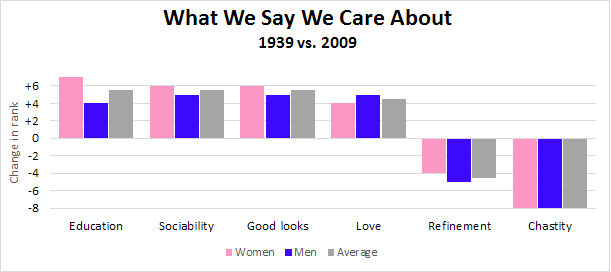Wonkblog points us today to a chart from Max Roser showing how men and women rated various aspects of potential mates in 1939 vs. 2009. (Since 1939 is the comparison year, it goes without saying that we’re talking about straight, cis, and most likely white folks here.) You can see the entire set of data at either of the links above, but I was interested mainly in the traits that have moved up or down significantly over that period. Here they are, in a handily color-coded pink and blue chart:

What can we tell from this? For starters, keep in mind that this is what people say they value, not what they actually value. “Similar political background,” for example, has allegedly moved up only one spot, from dead last to almost last, so it’s not in my chart. But there’s considerable evidence that a lot of people today would rather have their big toes cut off than associate with someone of the opposite party. So take all of this with a grain of salt.
Anyway, obviously chastity is out the door. No one cares anymore. Refinement is now decidedly old-fashioned, replaced by a desire for the more egalitarian virtue of sociability. And love has zoomed up to the top of the chart. (Allegedly, anyway.)
Beyond that, the two big movers are education and good looks. Apparently we all want mates who are both smart and gorgeous, which might go a long way toward explaining why marriage seems to be in decline. How many smart, gorgeous people are there in the world, after all? And if they have to be gregarious too—well, you’re just being mighty picky. Good luck.
Notably, the boring traits haven’t changed much: dependability and stability were near the top of the chart in 1939, and they’re still there now. I guess meat and potatoes are always in fashion. Or so we tell the pollsters, anyway.

















